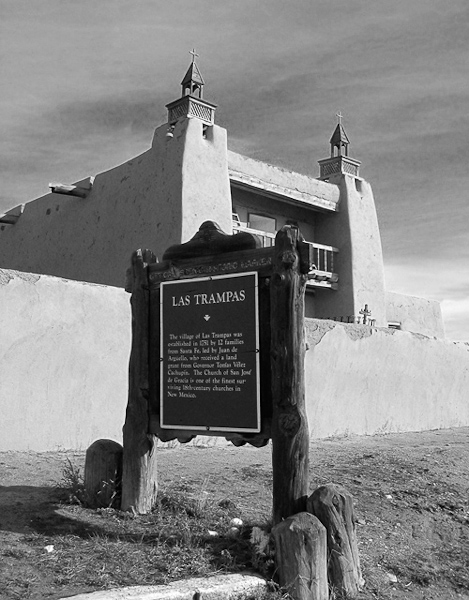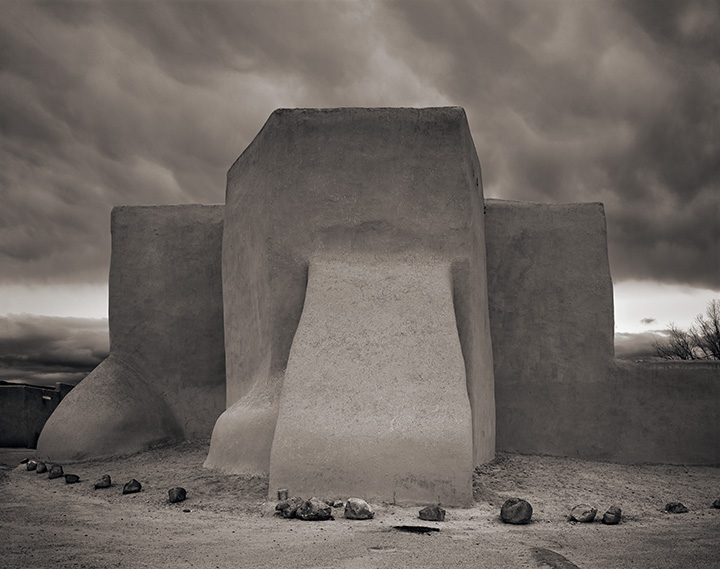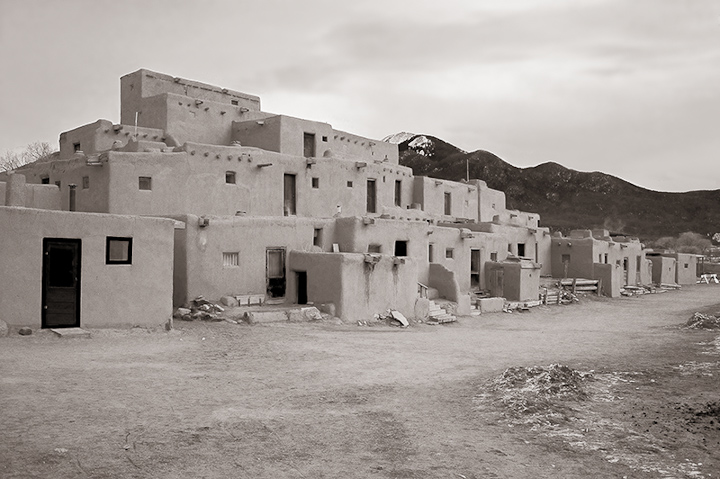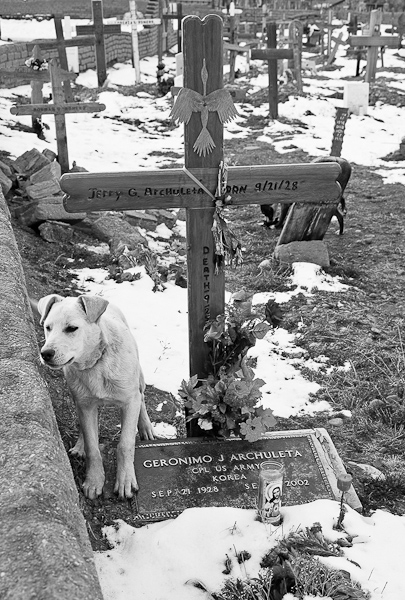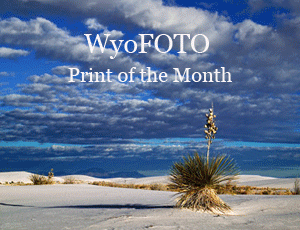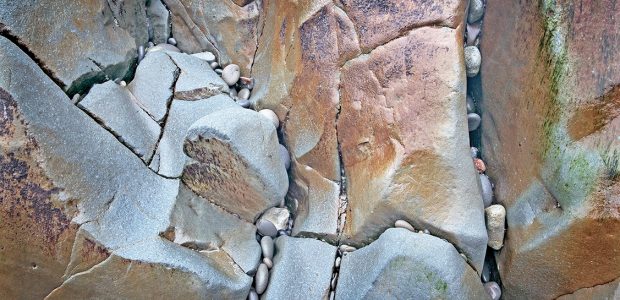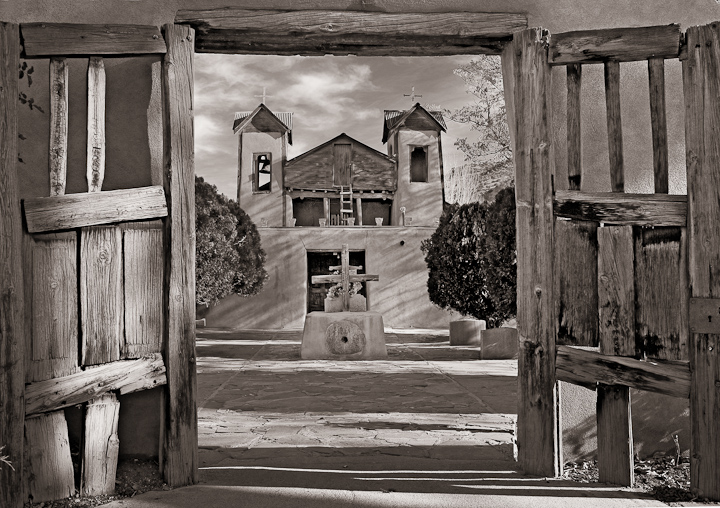

On the High Road
Santa Fe, New Mexico was established as the capital of the Spanish “Kingdom of New Mexico” in 1607. It is the cultural capital of the Southwestern US and a destination of many photographers. It has much to offer in the way of visual variety and aesthetic appeal. Photographically speaking, it is a major league attraction.
As is often the case in life, big things cast a giant shadow which leave lesser beings in the dark, unseen. The high road to Taos is one of those very special lesser beings. It is full of photographic gems, awaitng the light of day to ignite their sparkle .
Traveling north from Santa Fe on federal highway 84, the “High Road to Taos” leaves the main highway near the town of Santa Cruz. It starts as NM road 76 and heads first to Chimayo. It then heads north to Chamisal. Shortly after Chamisal it turns right and briefly becomes NM 75. Shortly after Vadito it turns left and follows NM 518 all the way to Rancho De Taos and Taos itself.
The interactive google map at right shows you the route. You can click on it, pan and zoom to see the route clearly.
The paragraphs below, discuss what are in my opinion the best photo locations on the route. Feel free to find other gems I have have missed along the way.
In my opinion, B&W captures the essence of these sites better than color. Your mileage of course, may vary.

About six miles down the road after turning off on highway 76 we enter the town of Chimayo. It is the home of El Santuario de Chimayo. Legend has it, in 1810, a Chimayo friar, Don Bernardo was performing penances when he saw a light burst forth from a hillside.
Drawn to the rays of light, he dug in the dirt and discovered a large wooden crucifix, which he named for Our Lord of Esquipulas, also known as the “Black Christ”. A local priest moved the crucifix to Santa Cruz, but three times it disappeared and then reappeared back in its hole. By the third time, everyone understood that El Senor de Esquipulas wanted to remain in Chimayo, and so a small chapel was built on the site. Then the miraculous healings began.
The soil at El Santuario was believed to produce a mud that, when eaten or applied to the skin, had miraculous healing powers. The crippled, blind, and those afflicted with other diseases came to be cured, when all other treatments failed.
El Santuario de Chimayo has been called the “Lourdes of America”.People come to the Santuario in the thousands, close to 300,000 a year. They come to worship the Almighty, to ask for peace in the world and in their hearts, to fulfill a promise, to feel the healing touch of God.
Whether you are a believer or not, El Sanctuario is impressive visually, the chapel, the grounds, the worshippers, speak of our humanity. It will challenge you to capture its essence with your camera.
After leaving Chimayo, its about 17 miles further down highway 76 that we arrive in Las Trampas. Las Trampas is the home of San Jose de Gracia church.
The village of Las Trampas (Santo Tomás del Río de las Trampas) was established around 1751. Las Trampas was initially considered too small to have its own resident priest. At first, Franciscans from the nearby Picuris Pueblo served the faithful.
Dedicated to Saint Joseph and completed about 1776, San Jose de Gracia is a National Historic Landmark, and has been called “the most perfectly preserved church in the United States.” San José de Gracia is considered to be the finest example of early mission churches in New Mexico
In New Mexico, traditional villages were organized and built around a plaza and during times of war, could be blocked to serve as a fortress. The Las Trampas village and the church were constructed in this protective, walled style.
This church is in remarkable shape considering its age and constant use, being well-preserved by the extremely dry climate. The church has a single nave plan 100 feet long by 52 feet wide. The main doors are framed by two recently restored bell towers.
While not as spiritually sigmificant as El Sanctuario, San Jose de Gracia is a better example of the architecture of its genre and a photographic challenge in that light.
Moving north from Las Trampas, we intersect highway 518, and in about 28 miles we enter Ranchos de Taos. Ranchos de Taos is the home of San Francisco de Asis church.
Rancho de Taos is located just south of Taos and was settled in 1716. The church was built after missionaries became established in the area. It was constructed under the direction of Franciscan Fray José Benito Pereyro. Its’ thick fortress-like walls define its previous use as a fortification. It was built to resist unwanted attacks from local aggressive Indian tribes or Apache invaders.
It has been a center of spiritual life in the Taos area for over 250 years. Even today it actively serves a congregation of more than 1,200 families.
No other Southwestern church has a greater presence in the world of art. San Francisco de Asis Church has been a great inspiration to artists such as photographer Ansel Adams and painter Georgia O’Keeffe.
San Francisco de Asis is the most architecural unique church of all the Spanish missions in New Mexico. It will be a challenge for your creative abilities. When you pull out your camera here, you will be standing in the shadow of some very tall trees, photographically speaking.
Leaving Rancho De Taos and heading North through the town of Taos itself, we arrive at Taos Pueblo. The multistoried adobe buildings of the pueblo have been continuously inhabited for over 800 years. It is in fact, the longest continually settled community in North America and is a World Heritage Site.
Most archeologists believe that the Taos Indians, along with other Pueblo Indians settled along the Rio Grande, migrated from the Four Corners region. The dwellings of that region were inhabited by the Anasazi, and a long drought in the area in the late 13th century may have caused them to move to the Rio Grande, where the water supply was more dependable.
The North-Side of the Pueblo is said to be one of the most photographed and painted buildings in North America . It is the largest multistoried Pueblo structure still extant, surpassing even Acoma Pueblo in size. Its’ adobe walls are often several feet thick. Its primary purpose was also for defense. As late as 1900, access to the rooms on lower floors was by ladders on the outside to the roof, and then down an inside ladder. In case of an attack, outside ladders could easily be pulled up.
The history of Taos Pueblo includes the plotting of the Pueblo Revolt in 1680, and a siege by U.S. forces in 1847
The religions still represented in the Pueblo include Chrisitianity, the Native American Church and the native aboriginal religion.
The deep feeling of belonging to a community, summed up in their phrase, “we are in one nest,” has held the Taos people together. Both men and women are expected to offer their services or “community duties,” when needed. One should be cooperative and never allow their own desires to be destructive of the community’s interest.
One of Taos’s strongest institutions is the family. Descent on both the father and the mother’s side of the family is equally recognized. Each primary family lives in a separate dwelling so when a couple gets married, they move to their own home.
Culturally the most significant event in the pueblo is the Pow Wow. The term pow wow comes from the Algonquin nation of the Eastern Woodlands, meaning “a gathering of spiritual leaders.” Since the early days, Europeans thought “pow wow” referred to any large gathering of Indian people. Now it is a name often used for Indian celebrations.
The Taos Pueblo pow wow is normally held the second week in July. It provdes the best opportunity to photograph Pueblo residents in their native garb and performing their traditional dances.
At this point we have reached the end of high road and it’s time to bid it our farewell.
About Miles Hecker
Miles has been involved with photography for over forty years. He teaches digital photography at Casper College in Casper,Wyoming. His photos have won awards fromNatures Best magazine,Photo.net, The Luminous LandscapeandWyoming WIldlife . Miles’ photos have been published in American Vignette, Backpacker Magazine, Natures Best Images, Popular Photography, Wyoming Audubon, and Wyoming Wildlife. He is co-founder ofWyoFOTO LLC.
Geotagged Photolocation Index

Lorem ipsum dolor sit amet, consectetur adipiscing elit, sed do eiusmod tempor incididunt ut labore et dolore magna aliqua. Ut enim ad minim veniam, quis nostrud exercitation ullamco laboris nisi ut aliquip ex ea commodo consequat. Duis aute irure dolor in reprehenderit in voluptate velit esse cillum dolore eu fugiat nulla pariatur. Excepteur sint occaecat cupidatat non proident, sunt in culpa qui officia deserunt mollit anim id est laborum.
You May Also Enjoy...
Visualization and The Evolution of Conscious Awareness
FacebookTweet “No man steps in the same river twice, for its not the same river and he’s not the same man”. Heraclitus Is there a
